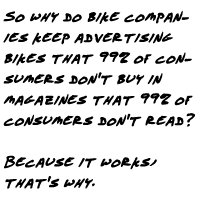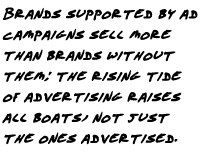One of the most common complaints I hear from bike shop owners goes something along the lines of "Why do you guys even bother advertsing in those magazines (or on those websites)? Ninety-nince percent of my customers don't read them. And even if they did, 99 percent of them don't buy the kinds of bikes you advertise there."
And you know what? They're right on both counts.

So why do bike companies keep advertising bikes that 99 percent of consumers don't buy in magazines that 99 percent of consumers don't read?
Because it works, that's why.
Let me explain.
Lies, Damned Lies, and Statistics
Last time I checked, which is to say, the last time someone paid me to check, there were not quite 6 million non-mass-market bikes sold in the USA per year. That's bikes sold in bike shops, specialty sporting goods stores, and what the industry calls "other," which is places like REI, Performance, and so forth.
That's a lot of bikes. And only about one-and-a-half million of them are in the $1,000-and up category that cycling magazines like to talk about.
About the same time, the combined circulation of all the major print cycling magazines was about half a million, by the time you eliminated duplicate readers (i.e., people who read more than one title, which in my experience, is most all of them). Ditto for websites, although that number has probably grown.
That's not very many readers. But it turns out those readers are an incredibly important part of the equation when it comes to the purchase of those 6 million new bicycles each year.
(By the way, let me say again these numbers are several years old, so don't use them for your term paper or anything. But I think they're plenty close enough to make my point about bike ads and how they work. Also, this reasoning works for equipment as well as bikes.)
Key Influencers, and What's So Key About Them
My colleague Ray Keener calls them "Expert Counselors" in this blog post, but in Marketingspeak we refer to them as Key Influencers. In fact, there's a whole branch of marketing devoted exclusively to the art and science of reaching these folks and marketing through them, but in the bike biz we've sort of figured out how to do it by trial and error.

Basically, there are three types of Key Influencers that cycling magazines and the ads in them are designed to appeal to:
- "My friend who knows a lot about bikes." These are cyclists, bless them, who are incredibly involved in the technical minutia of the products those of us in the industry make and sell. They are also the primary consumers of content marketing. Levels of actual expertise range from opinionated blowhards to genuine experts who would give seasoned product managers a run for their money. They also have an impact on brand and product preference which is far out of proportion to their numbers and savvy advertisers ignore them at their peril.
- Bike shop employees. The men and women who actually sell bikes and equipment to cyclists day in and day out are by far the biggest influencers of consumer choice, and having them on your brand's side is quite literally money in the bank. Along with other factors like the product selection their business carries, these people also read bike magazines and are influenced by what they read there. So ads in bike magazines—not to mention product reviews and online "chatter" about your brand— can help you win share of mind with these most key of influencers.
- Sales reps. Obviously salespeople don't need to be influenced by magazine or website ads— after all, they're being paid to be advocates for your brand already—but your ads can become powerful tools for them to take into bike shops to advocate for support of your brand. Advertising shows retailers how you are supporting them in the market and lets them know that other key influencers will be sending prospects into their business with your brand at the top of their minds.
Other reasons for advertising top-of-the line products are the facts that those higher price points are where there's the greatest opportunity to influence individual purchases (remember those 1.5 million $1,000-plus units per year we mentioned back at the top of the page?) and because that's where the biggest profits are, both in terms of margins and flat-out dollars. No wonder the competition at these price points is so fierce.
Finally, the whole system works only because the costs of advertising can be spread among all the products a brand makes.
But here's the bottom line. We (I mean we as an industry, not the royal we or the editorial we) have seen the results, and we've seen it with any number of brands. Brands supported by ad campaigns sell more than brands without them; the rising tide of advertising raises all boats, not just the ones advertised. That's not to say that advertising will make up for mediocre product or late delivery, just that brands supported by it do better than brands without it. And, BRAIN publisher Marc Sani hastens to add, that goes double for trade ads.
Editor's note: Rick Vosper's quarter century in the cycling business includes executive stints as director of Airborne Bicycles, director of global marketing for Specialized Bicycles, and VP of marketing & [roduct for Veltec Sports. Outside the cycling industry, he's worked as an award-winning copywriter and creative director for advertising, collateral, web, and multimedia agencies.
To discus this blog, or any other article on BicycleRetailer.com, please visit our Facebook page.



